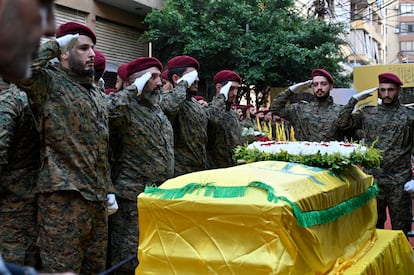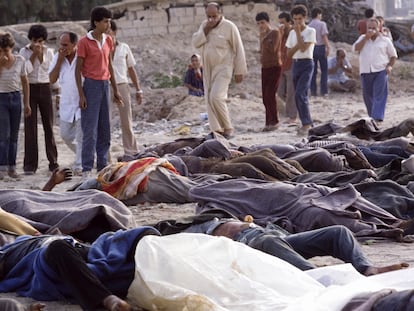Hezbollah, the best armed militia in the world
The military capabilities of the Lebanese fundamentalists are far inferior to Israel, but considerable nonetheless. It has missiles capable of hitting any point in Israeli territory if they get past its sophisticated anti-aircraft defenses


Israel has one of the most powerful and sophisticated armies in the world, and an arsenal including nuclear weapons. It also has one of the largest militaries relative to its population, which is slightly less than 10 million inhabitants: almost 170,000 active-duty soldiers. By contrast Spain, with a population of almost 49 million, had fewer than 117,000 regular troops in 2022, according to official data. Added to Israel’s standing army are 465,000 reservists who can be called up in the event of war, of whom 360,000 have already been mobilized in the almost 12 months of the Gaza conflict. The military capacity of the Lebanese Shia party-militia Hezbollah cannot even remotely compare with that of the Israel Defense Forces (IDF). It is not an insignificant enemy, however. The data on its arsenal are partial and, in many cases, come from calculations based on information from Israel and its main ally, the United States, so they may not be precise. They do though provide an idea of why many experts consider Hezbollah to be the best-armed non-state actor in the world, with the backing of Iran, but also of Syria. It even stocks medium- and long-range missiles in its warehouses, capable of hitting the entirety of Israel’s territory and its vital infrastructure, if they manage to get past Israel’s Iron Dome anti-aircraft defences. On Wednesday, Hezbollah targeted the headquarters of the Mossad intelligence services in the Tel Aviv region with a ballistic missile, which was intercepted.
Fighters
Hezbollah leader Hassan Nasrallah recently reportedly increased his number of fighters to 100,000, a figure that Western foreign ministries reduced to less than half. According to a report by the bipartisan U.S. think tank Center for Strategic and International Studies (CSIS), Hezbollah “has about 30,000 active fighters and up to 20,000 reserves, and its forces consist primarily of light infantry, which have historically been trained and built for stealth, mobility and autonomy.” The CSIS cites an example, referring to the last major Israeli invasion of Lebanon in 2006. Then, “[the militia’s] rocket units were designed to establish a launch point, fire, and disperse in less than 28 seconds, using pre-positioned equipment, underground shelters, and mountain bikes.”
The militia has extensive experience in guerrilla warfare and urban combat. In addition, CSIS stresses, the group’s experience “fighting in support of Bashar al-Assad in Syria over the past decade has given it access to capabilities and skills used by conventional armies.” Haizam Amirah Fernandez, an analyst specializing in international relations in the Middle East, recently highlighted another advantage to this newspaper: motivation. In the case of a hypothetical Israeli invasion, Hezbollah members would be fighting “to defend their land” from an attack by another state. Despite its not inconsiderable military capacity, since October 2023, when it began its low-intensity war with Israel, Hezbollah has lost commanders and hundreds of combatants. Last week, some 1,500 militiamen were wounded, according to a militia source cited by Reuters, by the detonations of more than 5,000 pagers and walkie-talkies. Even so, in the event of a total war, this militia would be “a formidable enemy,” the American think tank stresses.
Rockets, missiles and tanks
Hezbollah has, according to estimates from various sources, between 120,000 and 200,000 rockets and missiles, most of them small, unguided, easily transported surface-to-surface artillery rockets, most notably the Katyusha rocket launchers, used extensively in the 2006 war and supplied mainly by Iran. Since then, “Hezbollah has dramatically increased its access to long-range missiles” — with ranges of up to 500 kilometers (310 miles), that is, capable of hitting targets from the north to the south of Israel — CSIS notes, “meaning that much of Israel will feel the threat of Hezbollah attacks if the conflict escalates.” Only “a few hundred at most” of these missiles are guided, but the precision of these weapons “provides Hezbollah with the ability to strike high-value targets, vital economic centers, and critical infrastructure.”
Hezbollah has also had access to Russian-made tanks, such as T-72s, through its involvement in the Syrian war. However, it is not clear whether the militants are trained to use or repair them. The tanks would also be easy targets for sophisticated Israeli fighter jets and drones.
Drones
Iran, Hezbollah’s main arms supplier, has provided the bulk of the unmanned aircraft it uses, including the Ayoub (Shahed-129), Mirsad 1 and 2, and Karrar models. It stocks commercial quadcopters and surveillance and attack drones, CSIS notes. The operators of these drones have been trained by the elite Quds Force, the regional arm of Iran’s parallel army, the Revolutionary Guard.
Anti-tank missiles and anti-aircraft defense
Hezbollah uses anti-tank missiles, dubbed “Thar Allah,” specifically designed to overcome the protection system of Israeli Merkava tanks, the Lebanese satellite television channel Al Mayadeen confirmed last October, although it is not known whether they are effective. The militia also installs “Kornet anti-tank missiles on all-terrain vehicles,” the CSIS report said. Since 2006, Hezbollah has received anti-aircraft guns, portable air defense systems and short- and medium-range surface-to-air missile systems manufactured in Iran and Russia. None of these weapons are capable of countering Israel’s overwhelming air superiority, which includes around 30 state-of-the-art F-35 fighter jets. But this hegemony is no longer absolute, as it was in the past.
Geography and tunnels
Hezbollah militants are familiar with the rocky hills of southern Lebanon. In that terrain, “any heavy Israeli ground military force attempting to move through the region would likely be restricted to the main, compact roads due to the mountainous terrain and therefore vulnerable to harassment” with anti-tank weapons, explosive devices, and ambushes, CSIS warns. Like Hamas in Gaza, Hezbollah has built a network of tunnels and bunkers in those hills, which it is believed are used to launch rocket attacks and hide ballistic missiles. Iran and North Korea helped build the tunnel network after Israel’s 2006 invasion, according to a report by Alma, an Israeli think tank specializing in the Lebanese Shia militia, as cited by Reuters.
Sign up for our weekly newsletter to get more English-language news coverage from EL PAÍS USA Edition
Tu suscripción se está usando en otro dispositivo
¿Quieres añadir otro usuario a tu suscripción?
Si continúas leyendo en este dispositivo, no se podrá leer en el otro.
FlechaTu suscripción se está usando en otro dispositivo y solo puedes acceder a EL PAÍS desde un dispositivo a la vez.
Si quieres compartir tu cuenta, cambia tu suscripción a la modalidad Premium, así podrás añadir otro usuario. Cada uno accederá con su propia cuenta de email, lo que os permitirá personalizar vuestra experiencia en EL PAÍS.
¿Tienes una suscripción de empresa? Accede aquí para contratar más cuentas.
En el caso de no saber quién está usando tu cuenta, te recomendamos cambiar tu contraseña aquí.
Si decides continuar compartiendo tu cuenta, este mensaje se mostrará en tu dispositivo y en el de la otra persona que está usando tu cuenta de forma indefinida, afectando a tu experiencia de lectura. Puedes consultar aquí los términos y condiciones de la suscripción digital.
More information
Archived In
Últimas noticias
Sydney Sweeney, the actress praised by Trump: ‘Women are up against what society wants them to be’
The Bolsonaro surname: An advantage or liability in Brazil’s 2026 presidential elections?
Raúl Rocha, from jet-setting with Miss Universe to arms trafficking and fuel theft
80,000 barrels of Mexican oil sent to Cuba: Havana drawn into the US–Mexico clash
Most viewed
- Reinhard Genzel, Nobel laureate in physics: ‘One-minute videos will never give you the truth’
- Pablo Escobar’s hippos: A serious environmental problem, 40 years on
- Charles Dubouloz, mountaineering star, retires at 36 with a farewell tour inspired by Walter Bonatti
- Why we lost the habit of sleeping in two segments and how that changed our sense of time
- The fall of a prolific science journal exposes the billion-dollar profits of scientific publishing









































